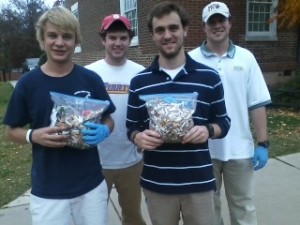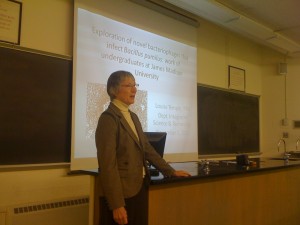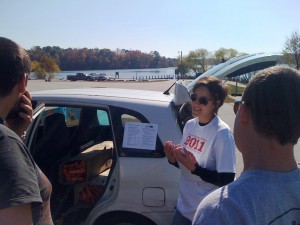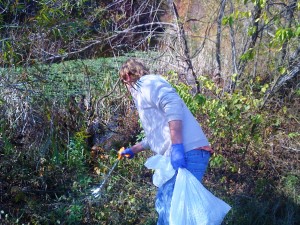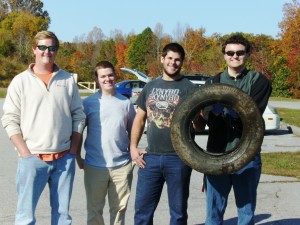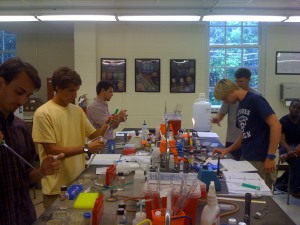Several students from Dr. Goodman's Environmental Biology class cleaned upcigarette butts around fraternity circle on Thurs, Dec 1. Patrick Adams,George Parrish, John Parrish, Matthew Gates, Matt Vail, Ibn Salaam, andJack Gibson (pictures below) each filled a sandwich bag full of butts-yummy! For more about the problem that cigarette butts pose as pollution,On Saturday, Dec 3, Colin Nickerson, Derrick Maxwell, and Patrick Lynch(pictured below) did a litter cleanup on the access road behind V-DOT.Among the regular trash items, they found over a hundred glass bottles,a tire, and an old street sign.Later on that day, Colin Nickerson, Nay Oo, Cody Murphey, and JacksonParker (pictured below) headed over to Briery Creek Wildlife ManagementArea, just south of the H-SC campus. They cleaned up trash around thedock, main parking lot area, and nearby walking trail.
Author Archives: admin
Seventeen new millipede species discovered
Dr. William Shear of the Hampden-Sydney College Biology department has published a paper in the international megajournal Zootaxa naming and describing 17 new species of millipedes from Virginia. The millipedes all belong to the genus Pseudotremia, which becomes the second-largest genus of millipedes in North America with the addition of these new species.
Species of Pseudotremia are often found in caves, and relatively more rarely on the surface. Animals that have adapted to the cave environment are called troglobionts, and often have characteristic adaptations to the limited environment in caves. They tend to lose eyes and pigment, and become smaller than their above-ground relatives. Their legs and antennae evolve to become longer because they rely more on touch or subtle vibrations to find food.
While some Pseudotremia species are fairly widespread and occur in several Virginia counties, some of those described in the new paper are known only from single caves. These species are highly vulnerable to extinction unless action is taken to preserve their cave habitat.
Mexican cave-dweller named for Dr. Shear
Prof. Gonzalo Giribet at Harvard University has named a new genus of cave-dwelling harvestman from Mexico for Dr. William Shear of the Hampden-Sydney Biology department. The new genus goes by the name of Shearogovea, combining Dr. Shear’s name with “-ogovea,” a combining stem used in the group of harvestmen to which the new genus belongs.
The new genus contains only one species, Shearogovea mexasca (Shear), found in a few caves in the Mexican state of Oaxaca. The species is eyeless, pale and long-legged–typical for cave-dwelling or troglobiotic animals. Shearogovea mexasca was originally described in 1977 by Dr. Shear, who placed it in a different genus, while admitting that it probably didn’t belong there. Dr. Giribet was able to establish, through extensive observations, that the species was so isolated from all its possible relatives that it deserved a genus name of its own. While new species are frequently discovered by biologists, the discovery of a new genus happens far less often.
Cleanups for BIOL 108 Environmental Biology
Two groups of students recently conducted litter cleanups at/near H-SC as part of Dr. Goodman’s BIOL 108 Environmental Biology class.
On November 15, Matthew Gates, George Parrish, Mack Garret, John Parrish, and Matt Vail (pictured above) picked up hundreds of cigarette butts around the major dorm building and classrooms on campus. Most people don’t realize that these are plastic, NOT biodegradable, and toxic hazards to wildlife for years or decades after disposal (click here for more info). So remember to always mind your butts and tell your friends and family to safely dispose of them in proper receptacles!
On November 7, the following students (some shown above) collected several bags of litter from a local highway near the H-SC campus: Matthew Gates, George Parrish, Matt Vail, Patrick Adams, John Parrish, Alexander Tharp, Ryan Davis, Nick Caporale, Mac Garret.
Nice job, guys!!
H-SC Students Present Cancer Research at National and International Meetings
Over the weekend of November 11-13, two Hampden-Sydney biology majors, Osric Forrest ’12 and Yonathan Ararso ’13, presented findings from the cancer research they have been conducting with Biology Professor Dr. Kristian Hargadon at two research conferences. Dr. Hargadon’s laboratory has recently demonstrated that melanoma tumor cells are capable of suppressing the activity of dendritic cells, a major regulator of host anti-tumor immune responses. At the 2011 Sigma Xi Annual Meeting and International Research Conference held in Raleigh, NC, Yonathan Ararso presented a poster of his work that aims to understand the mechanism by which melanoma cells suppress dendritic cell function. Several states away in St. Louis, MO, Osric Forrest presented a portion of his current Honors Project research on the influence of melanoma-altered dendritic cells on T cell activation at the 2011 Annual Biomedical Research Conference for Minority Students. The overarching goal of both of these projects is ultimately to identify strategies for interfering with anti-tumor immune suppression and enhancing anti-tumor immune responses. Both posters were very well received, and the conferences offered valuable research and networking experience for both Yonathan and Osric!
Seminar connects H-SC molecular biology students to fellow HHMI undergraduates
Hampden-Sydney was pleased to host Dr. Louise Temple from James Madison University to learn about her efforts to better understand the diversity of bacteriophage, or viruses that infect bacteria, in the environment of Virginia and beyond.
The visit from Dr. Temple was part of Hampden-Sydney’s first semester as an associate member of the Howard Hughes Medical Institute (HHMI) Science Education Alliance, a program that introduces original research work in bacteriophage biology to undergraduates at ~80 colleges and universities nationwide. Dr. Temple was an integral part of JMU’s charter membership in the alliance and met individually with H-SC students currently working on the HHMI phage isolation project to help them refine their projects. The year-long project at H-SC will culminate next spring in part with a meeting of undergraduates from H-SC, the College of William and Mary, Virginia Commonwealth University, the University of Mary Washington, and James Madison University in which research results from the bacteriophage project will be presented by student participants.
Sandy River Reservoir Cleanup on Oct 30
On Sunday October 30, 11 volunteers including Drs. Rachel Goodman and Mike Wolyniak and H-SC students conducted a waterway cleanup as part of the Ocean Conservancy’s International Coastal Cleanup. This event involves people from over 75 countries removing millions of pounds of trash from beaches and waterways, and is headed locally by Clean Virginia Waterways.
In two hours, the crew picked up over 100 pounds of litter, including plastic bags, food wrappers, and fishing lines which are dangerous for animals that can be entangled and choked by them.
Over 200 cigarette butts were collected. Most people don’t realize that these are plastic, NOT biodegradable, and toxic hazards to wildlife for years or decades after disposal (click here for more info). So remember to always mind your butts and tell your friends and family to safely dispose of them in proper receptacles!
Osric Forrest ’12 Conducts Honors Research on Immunity to Melanoma
Osric Forrest, a current senior biology major at H-SC, is conducting Departmental Honors research on immune responses to melanoma under the guidance of Dr. Kristian Hargadon. Previous work by Osric and other undergraduates in Dr. Hargadon’s lab has demonstrated that melanoma tumors are capable of suppressing the maturation and activation of dendritic cells, an immune cell type that is critical for the activation and reruitment of other immune cells to tumors. Osric’s Honors Research project is aimed at understanding how these tumor-altered dendritic cells influence the quality of T cell activation. As part of his research, Osric is utilizing a number of cutting-edge laboratory techniques that include magentic activated cell sorting, ELISA, and flow cytometry. Gaining a better understanding of how melanomas influence anti-tumor immune responses will further our understanding of mechanisms of tumor immune escape and may suggest novel approaches for enhancing the immune response to this cancer.
Biology student presentation at regional undergraduate conference
Sweet Briar College recently hosted the 13th annual Mid-Atlantic Regional Conference of Undergraduate Scholarship (MARCUS) , a meeting featuring the research activity of undergraduate students from across the state representing all academic disciplines. Henry Loehr ’13 presented a poster featuring his summer research on the genomics of Arabidopsis thaliana, a small plant that is a model for the genetics of more complicated organisms.
Phage hunting at H-SC
This year’s Molecular Biology class is focusing on a year-long project in which Hampden-Sydney students isolate and characterize new mycobacteriophages from the environment. Mycobacteriophages are a type of virus that infect a specific kind of bacteria, including the variety responsible for tuberculosis. Learning more about the types of mycobacteriophage found in the environment can teach us a great deal about evolution as well as help to devise new ways to control tuberculosis bacteria populations. The course is a part of the Science Education Alliance (SEA), a group of ~80 institutions across the United States currently conducting this project as part of a larger initiative of the University of Pittsburgh and the Howard Hughes Medical Institute (HHMI). Students in the class have already found several varieties of new phage from soil samples that they have collected from around campus as well as their hometowns, and we will continue to post on the progress that is made here throughout the year!





